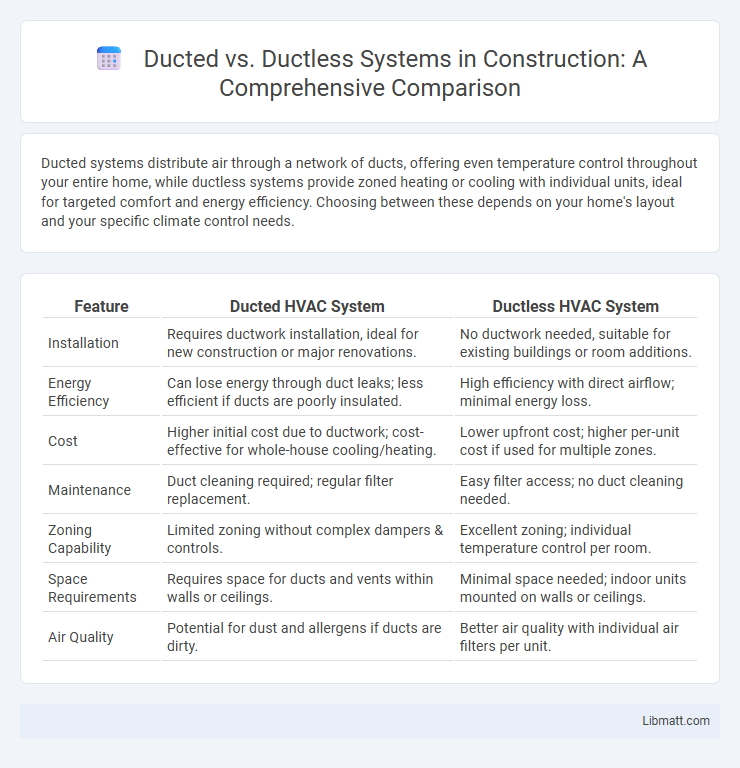Ducted systems distribute air through a network of ducts, offering even temperature control throughout your entire home, while ductless systems provide zoned heating or cooling with individual units, ideal for targeted comfort and energy efficiency. Choosing between these depends on your home's layout and your specific climate control needs.
Table of Comparison
| Feature | Ducted HVAC System | Ductless HVAC System |
|---|---|---|
| Installation | Requires ductwork installation, ideal for new construction or major renovations. | No ductwork needed, suitable for existing buildings or room additions. |
| Energy Efficiency | Can lose energy through duct leaks; less efficient if ducts are poorly insulated. | High efficiency with direct airflow; minimal energy loss. |
| Cost | Higher initial cost due to ductwork; cost-effective for whole-house cooling/heating. | Lower upfront cost; higher per-unit cost if used for multiple zones. |
| Maintenance | Duct cleaning required; regular filter replacement. | Easy filter access; no duct cleaning needed. |
| Zoning Capability | Limited zoning without complex dampers & controls. | Excellent zoning; individual temperature control per room. |
| Space Requirements | Requires space for ducts and vents within walls or ceilings. | Minimal space needed; indoor units mounted on walls or ceilings. |
| Air Quality | Potential for dust and allergens if ducts are dirty. | Better air quality with individual air filters per unit. |
Introduction to Ducted and Ductless HVAC Systems
Ducted HVAC systems use a network of ducts to distribute conditioned air throughout your home, providing consistent temperature control and centralized airflow. Ductless systems, also known as mini-split systems, operate without ducts, delivering targeted heating and cooling directly to individual rooms for enhanced energy efficiency. Choosing between ducted and ductless HVAC solutions depends on your home's layout, installation costs, and energy consumption goals.
How Ducted Systems Work
Ducted systems distribute heated or cooled air through a network of ducts installed within walls, ceilings, or floors, delivering conditioned air to multiple rooms via vents or diffusers. These systems rely on a central air handler or furnace that conditions the air before it travels through insulated ductwork, ensuring consistent temperature control throughout the entire building. Properly designed and sealed ductwork minimizes energy loss, optimizing HVAC efficiency and indoor air quality.
How Ductless Systems Operate
Ductless systems, also known as mini-split systems, operate by directly delivering conditioned air through individual indoor units without relying on extensive ductwork. Each indoor unit is connected to an outdoor compressor via a conduit housing refrigerant lines, enabling targeted heating or cooling in designated zones. This design enhances energy efficiency by minimizing the energy losses commonly associated with duct systems and allows for customizable temperature control in different rooms.
Energy Efficiency Comparison
Ducted HVAC systems often experience energy losses through leaks and poor insulation in ductwork, reducing overall efficiency by up to 20-30%. Ductless systems eliminate these losses by delivering conditioned air directly to rooms, enhancing energy efficiency and reducing utility bills. Your choice of a ductless system can lead to significant energy savings, especially in homes without existing ductwork.
Installation Process: Ducted vs Ductless
Ducted systems require extensive installation involving ductwork throughout your home, making the process more complex and time-consuming. Ductless systems, also known as mini-split systems, offer simpler installation with no need for ducts, involving only a small hole in the wall for the conduit. This streamlined approach often results in lower labor costs and less disruption during setup.
Cost Analysis: Upfront and Long-Term
Ductless systems generally have a higher upfront cost due to individual units and installation complexity, while ducted systems benefit from centralized airflow with potentially lower initial expenses if existing ductwork is present. Over the long term, ductless systems can offer energy savings by conditioning specific zones, reducing utility bills and maintenance costs, unlike ducted systems where energy loss through ducts may increase operational expenses. Your choice should weigh initial investment against anticipated energy efficiency and maintenance savings to determine the best cost-effective solution.
Maintenance Requirements for Each System
Ducted systems require regular inspection and cleaning of air ducts to prevent dust buildup and maintain optimal airflow, while ductless systems need periodic filter cleaning and occasional professional servicing to ensure efficient operation. You benefit from ductless systems' easier access for maintenance and reduced risk of mold growth compared to ducted systems. Both systems demand consistent upkeep, but ductless units generally offer simpler, less time-consuming maintenance.
Comfort and Air Quality Considerations
Ducted systems provide consistent airflow throughout multiple rooms, enhancing overall comfort by maintaining uniform temperatures and improving indoor air quality through centralized filtration. Ductless systems offer personalized climate control for individual spaces, reducing the risk of allergens and contaminants accumulating in ductwork, thus promoting healthier air quality. Both systems impact comfort and air quality differently, with ducted systems excelling in whole-home ventilation and ductless units offering targeted air purification in specific areas.
Ideal Applications for Ducted and Ductless Systems
Ducted systems are ideal for whole-home heating and cooling, providing consistent temperature control through a network of vents and ducts, making them suitable for larger spaces or new constructions with existing ductwork. Ductless systems excel in zones or specific rooms, offering flexibility and energy efficiency without the need for extensive duct installation, perfect for retrofits, additions, or spaces lacking ductwork. Your choice depends on the scale of the area needing climate control and whether you prefer centralized or distributed airflow solutions.
Choosing the Right System for Your Space
Ducted HVAC systems offer efficient whole-home heating and cooling through a network of ducts, making them ideal for larger spaces with existing ductwork. Ductless systems provide flexible, zone-specific climate control without the need for extensive installation, perfect for smaller homes or room additions. You should evaluate your space size, insulation, and budget to determine which system delivers optimal comfort and energy efficiency.
Ducted vs Ductless systems Infographic

 libmatt.com
libmatt.com